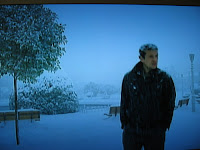In the giant cinematic world, it is easy to miss works by a certain director if one starts their film viewing at a later stage. If one started their film viewing from the 60's through to the 70's, then chances are they could have caught onto the new cinematic trends that were emerging then. But if someone (like myself) started their journey in the 90's, then one is always playing catch-up. Because in that case one has to not only keep pace with the existing cinema around the world but has to dip back into the past to see how the current cinema evolved. So it is not a surprize that I had completely missed the works of Alejandro Jodorowsky, the Chilean film-maker credited with kick-starting midnight cinema with his 1970 work, El Topo. I have viewed plenty of mid-night screenings over the last few years but I had remarkably never heard of Jodorowsky until recently, when his works were re-issued on DVD.
I decided to start my film journey before El Topo hoping to ease into Jodorowsky's style but as it turns out, my first choice of his 1968 film Fando and Lis was not an easy introduction. The opening images of Fando and Lis point to the surrealist film that awaits.
A woman singing in a junk yard. A piano literally on fire.



But these images are quite normal compared to what else unfolds in the film. The story centers around the two lead characters and their travels across a desolate and shattered land to search for the magical city of Tar. Lis is confined to a wheelchair, so Fando decides to carry her as they navigate the tricky mountainous paths to find the city which will cure all their problems. The two come across plenty of strange characters and situations but the characters around Fando and Lis are not all real. Flash backs of Fando's childhood are shown and they indicate that his nightmares are instead playing out in front of his eyes, as opposed to any real physical threat. Still, the surreal images continue as Fando tries to quieten his inner demons and desires, even by torturing the helpless Lis. Jodorowsky is not afraid to go all out with his nightmarish imagery and does not soften the plight of the two characters at all.
Desert: Bandits and Rogues:
The mountains in Fando and Lis give way to the beautiful deserts of Mexico in El Topo, a Western outlaw film not afraid to depict blood and the evil nature of men. The title character refers to a bandit who rides the desert with his 7 year old son, dispatching outlaws and bringing justice to the people.


On one such journey, El Topo rescues a few priests and finds a new lover. He leaves his son with the priests while he goes out to destroy all the 4 supreme masters in the desert to gain ultimate power. But El Topo does not play fair and defeats the masters with deceit.
 So it is not a surprize to find that El Topo gets double-crossed and left for dead.
So it is not a surprize to find that El Topo gets double-crossed and left for dead.At this point, one can say the film's second act starts with a newer and wiser El Topo emerging. He has been looked after by the cave people, men and women who hide beneath the earth living far from the corrupt and dangerous city above ground. But El Topo wants to return the people back to civilization. However, his new found values of peace come under severe challenge in a land where crime and corruption reign.
The film is not just a spaghetti western but is packed with religions undertones -- messages of Buddhism and Christianity are both mixed in varying degrees througout the film. And there are plenty of gory or offensive scenes in the film which allude to the film's popularity as a cult viewing. There are plenty of fascinating images scattered througout the film such as the surroundings of the 4 masters. The images of dead sheep lying as El Topo takes on the master is just one example.

Ratings:
Fando and Lis (1968): 6.5/10
El Topo (1970): 7.5/10










































